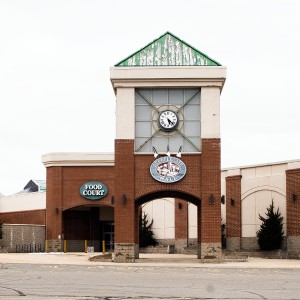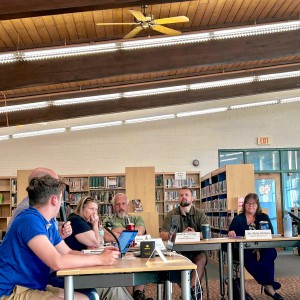‘A moving target’: How does state school building aid work? And how much can the middle school project expect?

Plans for a new Concord middle school to be built on raw land next to the Broken Ground and Mill Brook schools was chosen by members of the school board in a 6-3 vote Wednesday night.
| Published: 02-24-2024 11:30 AM |
In a best-case scenario, the Concord School District would receive no more than $32 million – less than half of what it asked for – in state money for the middle school project due to changes to the school building aid program taking effect this year.
“The problem is, it changes,” Superintendent Kathleen Murphy said at a meeting Friday morning attended by district leaders, city councilors and area lawmakers. “It’s a moving target.”
District leaders have sought to allay taxpayer sticker shock at the $176 million estimate put forward for the new middle school by emphasizing that the cost will only drop in the coming months and, they hope, be buoyed by a building aid package from the state. But the size of the aid won’t be known for more than a year, and is currently projected to fall far short of what the district is eligible to receive, according to state officials.
In the biennial budget, lawmakers can allocate money to help communities afford major construction projects like new schools, renovations, or additions. Lawmakers have no minimum amount of funding they must set aside for school building aid, but state law currently caps it at $100 million, or $50 million per year.
With that funding, the program first must meet two obligated payments. The first is what is commonly called the “tail” — continuing money to districts for projects previously awarded aid. The second payment is on a bond the state, overstretched on its aid commitments at the time, took out in 2010 — part of what precipitated the Department of Education to place a moratorium on building aid.
Concord was one of 17 districts that applied for building aid in 2022 when the moratorium was lifted. Those 17 school building applications were ranked based on deficiencies in their current facilities and their demographic needs. Concord’s middle school proposal was placed fourth in line, and has since moved up to second.
Money left over after the tail and bond are paid is then offered to the district at the front of the line. Districts get an offer based on how much of their costs are eligible for aid and must have local funding secured and be ready for construction to accept it.
After a district accepts an offer, or if that district takes a pass, the next project in line gets an offer based on what’s left. This continues until either the funding is exhausted or no project on the list is willing or ready to take the remaining funds.
Article continues after...
Yesterday's Most Read Articles
 Neighboring landowner objection stalls Steeplegate redevelopment approval
Neighboring landowner objection stalls Steeplegate redevelopment approval
 Women at work on Warren: New combined salon, spa, DIY and retail space opens in former Peter’s Images location
Women at work on Warren: New combined salon, spa, DIY and retail space opens in former Peter’s Images location
 As N.H. coal-fired plants shift to solar, offshore wind beckons
As N.H. coal-fired plants shift to solar, offshore wind beckons
 In Franklin, a Hometown Hero remains busy, 12 years after retiring from the U.S. Postal Service
In Franklin, a Hometown Hero remains busy, 12 years after retiring from the U.S. Postal Service
 For some older Jewish professors at Dartmouth and UNH, opposition to campus arrests feels personal
For some older Jewish professors at Dartmouth and UNH, opposition to campus arrests feels personal
 ‘Paradise Paradox’ – mental-health issues amid the wonders of a ski town
‘Paradise Paradox’ – mental-health issues amid the wonders of a ski town
In the fiscal year ending this June, Rochester accepted a $15.8 million aid award for a new elementary school and Monadnock accepted $19.4 million for a major renovation and addition, according to state records. It leaves $13.6 million left in the program this year, with Colebrook, estimated to be offered almost $10 million, at the front of the line.
The state passed a law in 2023 constricting the building aid program to an annual, rather than biennial, cycle. Rather than $100 million going out in offers over two years, $50 million, maximum, goes out each year, after the tail and bond are paid.
“It was a substantial change,” said Amy Clark, administrator of the Bureau of School Facilities in the Department of Education. The change lowers the ceiling on how much aid is available to a single project.
Concord will be at the front of the line come 2025. It asked for $70 million in aid on its application, and the state determined it is eligible for about $48 million.
Under the new annual cycle, Concord’s maximum possible award is either $29 million in late 2025 or $32 million a year later due to the obligations of the tail and the bond, according to Clark.
Those offers hold true only if the state budget starting in July 2025 fully funds the program — a big “if.” The legislature and new governor setting that budget are yet to be elected, and further reforms to the program are floating through the state house this session.
“We don’t have funding guaranteed,” Clark said. “We could be allocated no money, or we could be allocated some amount of money.”
Beyond question marks on the state budget, changes to the program before 2025 could also complicate the aid picture.
Senate Bill 443 originally created a $60 million minimum for annual building aid appropriations — it was amended earlier this year to cut that language. House Bill 546, which would have set a similar funding floor and allowed remaining aid money to rollover to the next year, was tabled. Meanwhile, a bill making charter schools eligible for the program, House Bill 354, and another that would largely dismantle it, Senate Bill 342, are still in play.
“We know it’s in flux. We know that there’s a lot of changes. It’s been that way for a number of years,” School Board President Pam Walsh said Friday. “Some of the changes just hit larger districts harder than others, because obviously we need larger buildings that are more expensive.”
Now that it has selected a location, a school board committee is beginning the process of creating a design with its architects. A detailed design — and therefore a more probable price tag on the project — is expected by September, according to the district’s timeline.
The next state budget will go into effect on July 1, 2025. With the level of funding for building aid set, any award offers would go out near the end of that year. To accept aid, Concord will need a finalized design, budget and approved local funding in hand. That means the school board, with a firm cost projection and knowledge of how much aid is available, will likely take a final vote on the project in the fall of next year, according to Business Administrator Jack Dunn.
As the district forges ahead, it does so knowing how volatile the aid process is, Walsh told the Monitor, and knowing that there is a possibility that it could get none.
“I think our focus right now is to do the best job we can on designing a cost-efficient building and pushing our legislators to fully fund building aid,” Walsh said.







 Adam Montgomery sentenced to minimum 56 years on murder charges in young daughter’s death
Adam Montgomery sentenced to minimum 56 years on murder charges in young daughter’s death Following budget cut, Pembroke revisits future of elementary school re-build
Following budget cut, Pembroke revisits future of elementary school re-build Granite Geek: Free government software for taxes – what could go wrong? (Not much, as it turns out)
Granite Geek: Free government software for taxes – what could go wrong? (Not much, as it turns out)
